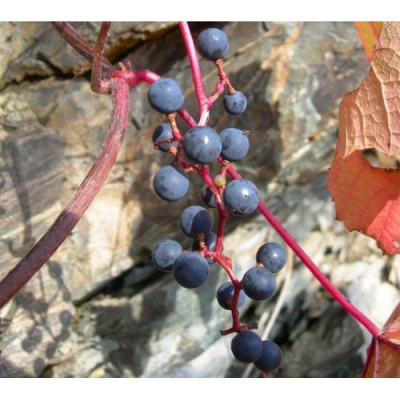
- Berry color: bluish black
- Taste: tart, sweet
- With bones: Yes
- Name synonyms: Coignetiae, Kempfera, Japanese
- Number of seeds, pcs.: 2-4
- Berry shape: spherical
- Berry size, mm: up to 8
- Pulp: juicy
- The power of growth: vigorous
- Yield: medium-yielding
The name of Coigne grapes sounds defiantly unusual. But this name hides quite a decent agricultural crop. It is only necessary to read it very carefully and draw the proper conclusions.
Breeding history
In this case, there is no need to talk about breeding work at all. The fact is that Coigne is not a variety, but a whole biological species. It is also called Japanese grapes, Kempfer grapes, and in foreign sources - Coignetiae. In fact, this is a natively cultivated wild-growing plant. It has been cultivated in Russia and other European countries since 1875.
Geography of distribution
You can meet Coigne:
on the main Japanese islands - Hokkaido, Honshu and Shikoku;
on the Korean Peninsula;
on Sakhalin;
in other regions of the south of the Far East.
Cultural use is possible in:
various regions of Ukraine and Belarus;
areas of the North Caucasus;
the European part of Russia (up to the latitude of Moscow).
Description
The Coigne grape is a typical woody vine. Important signs:
trunk with a diameter of 5 to 10 cm;
length up to 15, sometimes up to 18-20 m;
dark green flowers, ovoid or round;
small size of flowers;
grouping of flowers in short brushes with tomentose pubescence;
suitability for vertical gardening;
in autumn, the appearance of a dark green or crimson-red color of the leaves;
the ability of the antennae to make circular movements.
Ripening period
Coigne grapes will bloom in April or May. It depends on the actual weather and agricultural practices. But for some reason, there are no exact indications of the timing of the harvest in the available sources. It can be assumed that they coincide with the ripening dates of ordinary grapes.
Bunches
In the available sources, the type of brushes is not described. Their density and mass are also not characterized.
Berries
The grapes are globular. They are painted in black and purple or black and purple. The juice is almost absent. There are 2 to 4 seeds per berry.
Taste
This grape has a typical sweet taste. The characteristic tart notes are also traced in it. For your information: according to some sources, the edibility of the fruit is achieved only after freezing.
Yield
There is no special information on this in the available sources. Therefore, we can assume that the harvest is not standardized.


Growing features
Planting in acidic soil is recommended.Loams and light soils are preferred. A sun deck is required. Light shading is sometimes allowed. However, in the shade, the fruits become much smaller and lose their quality.
Strongly unacceptable:
heavy clay;
highly acidified areas;
waterlogged areas;
saline places.
Landing
You can breed a culture both with seeds and cuttings. Before sowing, the seeds must be stratified from 2 to 4 months; it is more practical to use winter cuttings. The seedlings will bloom at 5 or 6 years of age. Disembarkation is possible in spring or autumn. Peat, humus and coarse sand are placed in the planting pits, mixed with the ground.

Pollination
In the available sources, pollination is not characterized. But it is known that the Coigne grape is a dioecious plant. Therefore, you can use the same approach as for them.
Pruning
Again, there are almost no specific indications. However, the Kempfer grape grows strongly. Therefore, the need for pruning is undeniable. You need to be guided by a specific situation. It is worth noting that some sources recommend avoiding pruning, while others insist on it.



Frost resistance and the need for shelter
The plant resists strong cold weather well. Covering work is minimal. The whips need to be laid out on the ground. They are covered with peat or manure. Additionally, you can use spruce branches or other material.

Diseases and pests
Under normal conditions, Coigne grapes hardly get sick. But with strong moisture, it is affected by rot or other pathology. Preventive treatments are also not superfluous. The plant can be attacked by all the same insects that attack other species.

If a grape is exposed to any disease or insect, this always affects its appearance.
Storage
Long-term storage of the fruit of Japanese grapes is hardly possible. They are mostly eaten fresh. But as already mentioned, to give at least some taste, it is very important to freeze the berries. Recycling is hardly justified.











































































